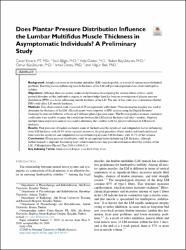Does Plantar Pressure Distribution Influence the Lumbar Multifidus Muscle Thickness in Asymptomatic Individuals? A Preliminary Study

Göster/
Erişim
info:eu-repo/semantics/openAccessTarih
2020Yazar
Karartı, CanerBilgin, Sevil
Dadali, Yeliz
Büyükturan, Buket
Büyükturan, Öznur
Özsoy, İsmail
Bek, Nilgün
Üst veri
Tüm öğe kaydını gösterKünye
Kararti, C., Bilgin, S., Dadali, Y., Büyükturan, B., Büyükturan, Ö., Özsoy, İ., & Bek, N. (2020). Does plantar pressure distribution influence the lumbar multifidus muscle thickness in asymptomatic individuals? A preliminary study. Journal of Manipulative and Physiological Therapeutics, 43(9), 909-921.Özet
Background: Atrophy can occur in the lumbar multifidus (LM) muscle quickly as a result of various musculoskeletal problems. Knowing factors influencing muscle thickness of the LM will provide important clues about lumbopelvic stability. Objectives: Although there are several studies in the literature investigating the adverse effects of foot–ankle postural disorders on the lumbopelvic region, to our knowledge there has been no investigation of plantar pressure distribution (PPD) as a factor influencing muscle thickness of the LM. The aim of this study was to determine whether PPD could affect LM muscle thickness. Methods: This observational study consisted of 25 asymptomatic individuals. Ultrasonographic imaging was used to determine the thickness of the LM. All participants were subjected to PPD analysis using the Digital Biometry Scanning System and Milletrix software in 9 different plantar pressure zones. The Pearson product-moment correlation coefficients were used to examine the correlations between the LM muscle thickness and other variables. Stepwise multiple linear regression analysis was used to determine the variables with the greatest influence on LM muscle thickness. Results: Peak pressures of medial and lateral zones of the heel were the significant and independent factors influencing static LM thickness, with 39.5% of the variance; moreover, the peak pressures of heel medial and fourth metatarsal bone were the significant and independent factors influencing dynamic LM thickness, with 38.7% of the variance. Conclusions: Plantar pressure distribution could be an important factor influencing LM thickness, although further research is required. Examining foot–ankle biomechanics may provide information about the stability of the LM. © 2020

















